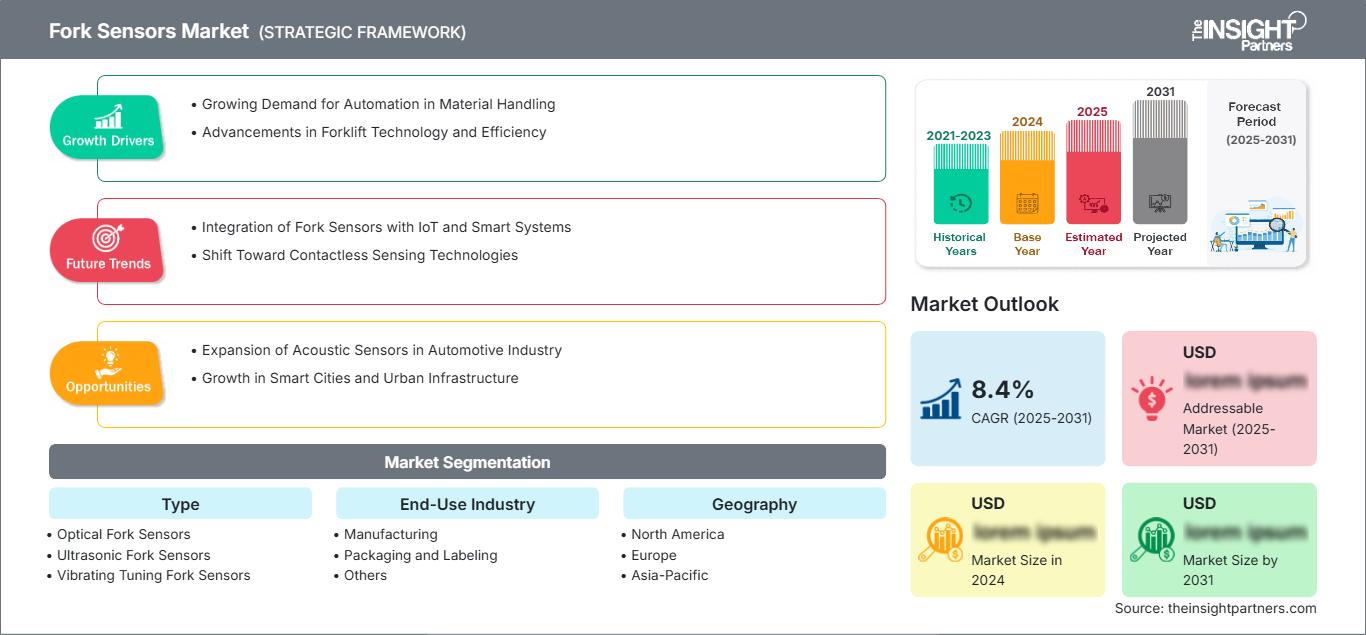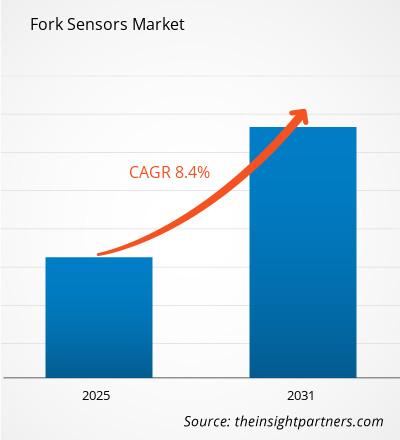Fork Sensors Market Growth, Trends, and Forecast by 2031
Historic Data: 2021-2023 | Base Year: 2024 | Forecast Period: 2025-2031Coverage: Fork Sensors Market covers analysis by Type (Optical Fork Sensors, Ultrasonic Fork Sensors, Vibrating Tuning Fork Sensors); End-Use Industry (Manufacturing, Packaging and Labeling, Others) , and Geography (North America, Europe, Asia Pacific, and South and Central America)
- Report Date : Feb 2026
- Report Code : TIPRE00007075
- Category : Electronics and Semiconductor
- Status : Upcoming
- Available Report Formats :


- No. of Pages : 150
The Fork Sensors Market is expected to register a CAGR of 8.4% from 2025 to 2031, with a market size expanding from US$ XX million in 2024 to US$ XX Million by 2031.
The report is segmented by Type (Optical Fork Sensors, Ultrasonic Fork Sensors, Vibrating Tuning Fork Sensors); End-Use Industry (Manufacturing, Packaging and Labeling, Others). The global analysis is further broken-down at regional level and major countries. The Report Offers the Value in USD for the above analysis and segments.
Purpose of the Report
The report Fork Sensors Market by The Insight Partners aims to describe the present landscape and future growth, top driving factors, challenges, and opportunities. This will provide insights to various business stakeholders, such as:
- Technology Providers/Manufacturers: To understand the evolving market dynamics and know the potential growth opportunities, enabling them to make informed strategic decisions.
- Investors: To conduct a comprehensive trend analysis regarding the market growth rate, market financial projections, and opportunities that exist across the value chain.
- Regulatory bodies: To regulate policies and police activities in the market with the aim of minimizing abuse, preserving investor trust and confidence, and upholding the integrity and stability of the market.
Fork Sensors Market Segmentation
Type
- Optical Fork Sensors
- Ultrasonic Fork Sensors
- Vibrating Tuning Fork Sensors
End-Use Industry
- Manufacturing
- Packaging and Labeling
- Others
You will get customization on any report - free of charge - including parts of this report, or country-level analysis, Excel Data pack, as well as avail great offers and discounts for start-ups & universities
Fork Sensors Market: Strategic Insights

-
Get Top Key Market Trends of this report.This FREE sample will include data analysis, ranging from market trends to estimates and forecasts.
Fork Sensors Market Growth Drivers
- Growing Demand for Automation in Material Handling: The increasing adoption of automation in industries like logistics, warehousing, and manufacturing is a major driver for the fork sensors market. Fork sensors are critical components in automated material handling systems, where they detect the presence of items on conveyor belts or forks of forklifts, ensuring smooth operations and minimizing human error. As industries continue to automate their processes, the demand for these sensors rises.
- Advancements in Forklift Technology and Efficiency: The modernization of forklift systems, including electric forklifts and automated guided vehicles (AGVs), is a key driver for the fork sensors market. These advanced systems require precise positioning and detection capabilities for optimal performance. Fork sensors enable greater accuracy in lifting and stacking operations, improving efficiency, safety, and productivity in warehouses and distribution centers.
Fork Sensors Market Future Trends
- Integration of Fork Sensors with IoT and Smart Systems: A key trend in the fork sensors market is the integration of these sensors with Internet of Things (IoT) and smart technologies. This integration enables real-time monitoring, data analytics, and remote troubleshooting of material handling systems. IoT-enabled fork sensors offer improved tracking and predictive maintenance, contributing to greater operational efficiency and minimizing downtime.
- Shift Toward Contactless Sensing Technologies: There is a growing trend in the fork sensor market towards the use of contactless sensing technologies, such as optical and laser sensors. These sensors offer advantages in terms of durability, accuracy, and reliability, as they do not require physical contact with the objects being detected. The shift to contactless sensors enhances operational efficiency and reduces maintenance requirements in environments like warehouses and factories.
Fork Sensors Market Opportunities
- Expansion of Acoustic Sensors in Automotive Industry: The automotive industry offers significant opportunities for acoustic sensors, particularly for applications related to vehicle noise monitoring, safety systems, and in-cabin comfort. Acoustic sensors are used to detect engine sounds, alert drivers to potential hazards, and monitor the interior environment for noise control. With the rise of electric vehicles and advancements in autonomous driving technologies, acoustic sensors are becoming a key component of the automotive sector.
- Growth in Smart Cities and Urban Infrastructure: The development of smart cities and the growing demand for smart infrastructure provide a promising opportunity for the acoustic sensors market. Acoustic sensors can be deployed in urban areas for noise pollution control, public safety monitoring, and traffic management. As cities worldwide become more connected and automated, the use of acoustic sensors for smart infrastructure applications is expected to increase, offering long-term growth prospects.
Fork Sensors Market Regional Insights
The regional trends and factors influencing the Fork Sensors Market throughout the forecast period have been thoroughly explained by the analysts at The Insight Partners. This section also discusses Fork Sensors Market segments and geography across North America, Europe, Asia Pacific, Middle East and Africa, and South and Central America.
Fork Sensors Market Report Scope
| Report Attribute | Details |
|---|---|
| Market size in 2024 | US$ XX million |
| Market Size by 2031 | US$ XX Million |
| Global CAGR (2025 - 2031) | 8.4% |
| Historical Data | 2021-2023 |
| Forecast period | 2025-2031 |
| Segments Covered |
By Type
|
| Regions and Countries Covered |
North America
|
| Market leaders and key company profiles |
|
Fork Sensors Market Players Density: Understanding Its Impact on Business Dynamics
The Fork Sensors Market is growing rapidly, driven by increasing end-user demand due to factors such as evolving consumer preferences, technological advancements, and greater awareness of the product's benefits. As demand rises, businesses are expanding their offerings, innovating to meet consumer needs, and capitalizing on emerging trends, which further fuels market growth.

- Get the Fork Sensors Market top key players overview
Key Selling Points
- Comprehensive Coverage: The report comprehensively covers the analysis of products, services, types, and end users of the Fork Sensors Market, providing a holistic landscape.
- Expert Analysis: The report is compiled based on the in-depth understanding of industry experts and analysts.
- Up-to-date Information: The report assures business relevance due to its coverage of recent information and data trends.
- Customization Options: This report can be customized to cater to specific client requirements and suit the business strategies aptly.
The research report on the Fork Sensors Market can, therefore, help spearhead the trail of decoding and understanding the industry scenario and growth prospects. Although there can be a few valid concerns, the overall benefits of this report tend to outweigh the disadvantages.
Frequently Asked Questions
What are the options available for the customization of this report?
What are the deliverable formats of the Fork Sensors market report?
What are the driving factors impacting the Fork Sensors market?
What are the future trends of the Fork Sensors market?
What is the expected CAGR of the Fork Sensors market?
-
Naveen is an experienced market research and consulting professional with over 9 years of expertise across custom, syndicated, and consulting projects. Currently serving as Associate Vice President, he has successfully managed stakeholders across the project value chain and has authored over 100 research reports and 30+ consulting assignments. His work spans across industrial and government projects, contributing significantly to client success and data-driven decision-making.
Naveen holds an Engineering degree in Electronics & Communication from VTU, Karnataka, and an MBA in Marketing & Operations from Manipal University. He has been an active IEEE member for 9 years, participating in conferences, technical symposiums, and volunteering at both section and regional levels. Prior to his current role, he worked as an Associate Strategic Consultant at IndustryARC and as an Industrial Server Consultant at Hewlett Packard (HP Global).
- Historical Analysis (2 Years), Base Year, Forecast (7 Years) with CAGR
- PEST and SWOT Analysis
- Market Size Value / Volume - Global, Regional, Country
- Industry and Competitive Landscape
- Excel Dataset
Recent Reports
Related Reports
Testimonials
The Insight Partners' SCADA System Market report is comprehensive, with valuable insights on current trends and future forecasts. The team was highly professional, responsive, and supportive throughout. We are very satisfied and highly recommend their services.
RAN KEDEM Partner, Reali Technologies LTDsI requested a report on a very specific software market and the team produced the report in a few days. The information was very relevant and well presented. I then requested some changes and additions to the report. The team was again very responsive and I got the final report in less than a week.
JEAN-HERVE JENN Chairman, Future AnalyticaWe worked with The Insight Partners for an important market study and forecast. They gave us clear insights into opportunities and risks, which helped shape our plans. Their research was easy to use and based on solid data. It helped us make smart, confident decisions. We highly recommend them.
PIYUSH NAGPAL Sr. Vice President, High Beam GlobalThe Insight Partners delivered insightful, well-structured market research with strong domain expertise. Their team was professional and responsive throughout. The user-friendly website made accessing industry reports seamless. We highly recommend them for reliable, high-quality research services
YUKIHIKO ADACHI CEO, Deep Blue, LLC.This is the first time I have purchased a market report from The Insight Partners.While I was unsure at first, I visited their web site and felt more comfortable to take the risk and purchase a market report.I am completely satisfied with the quality of the report and customer service. I had several questions and comments with the initial report, but after a couple of dialogs over email with their analyst I believe I have a report that I can use as input to our strategic planning process.Thank you so much for taking the extra time and making this a positive experience.I will definitely recommend your service to others and you will be my first call when we need further market data.
JOHN SUZUKI President and Chief Executive Officer, Board Director, BK TechnologiesI wish to appreciate your support and the professionalism you displayed in the course of attending to my request for information regarding to infectious disease IVD market in Nigeria. I appreciate your patience, your guidance, and the fact that you were willing to offer a discount, which eventually made it possible for us to close a deal. I look forward to engaging The Insight Partners in the future, all thanks to the impression you have created in me as a result of this first encounter.
DR CHIJIOKE ONYIA MANAGING DIRECTOR, PineCrest Healthcare Ltd.Reason to Buy
- Informed Decision-Making
- Understanding Market Dynamics
- Competitive Analysis
- Identifying Emerging Markets
- Customer Insights
- Market Forecasts
- Risk Mitigation
- Boosting Operational Efficiency
- Strategic Planning
- Investment Justification
- Tracking Industry Innovations
- Aligning with Regulatory Trends




















 Get Free Sample For
Get Free Sample For